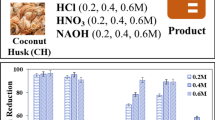Abstract
Biomass is considered a suitable coal alternative energy source because of its lower net emissions and acceptable heating values. The direct combustion of biomass in an industrial boiler can cause slagging and fouling of the boiler tubes because of the high content of alkali and alkaline earth metals (AAEMs) such as Na, Ca, Mg, and K present in the biomass. These minerals especially Na and K lower the melting point of ash and hinder complete combustion of the biomass. To mitigate such issues, biomass valorization methods are recommended out of which demineralization using acidic and basic reagents is notable. In this study, the effect of HCl, HNO3, and NaOH reagents on the physiochemical and thermal properties of corncob is investigated. Results show that the demineralization significantly affects the physiochemical and thermal characteristics of the biomass. Percent ash reduction is found highest (92.81%) when biomass is treated with 0.3 M HCl. However, the acidic treatment also dissolves cellulose and hemicellulose which degrades the thermal characteristics of the biomass. Treatment with NaOH is found less effective in removing AAEM; however, it increases the heating value of biomass by 11.02% and decreases the sulfur content by 68.89%.





Similar content being viewed by others
References
United Nations (2015) The Paris Agreement. https://unfccc.int/process-and-meetings/the-paris-agreement/the-paris-agreement
Hutt R Pakistan has planted over a billion trees. https://www.weforum.org/agenda/2018/07/pakistan-s-billion-tree-tsunami-is-astonishing/
British Petroleum (2017) BP Statistical Review of World Energy June 2017. 66:52 . doi: bp.com/statisticalreview
Farooq MK, Kumar S (2013) An assessment of renewable energy potential for electricity generation in Pakistan. Renew Sust Energ Rev 20:240–254
Raveendran K, Ganesh A, Khilar KC (1995) Influence of mineral matter on biomass pyrolysis characteristics. Fuel 74:1812–1822
Asonja A, Desnica E, Radovanovic L (2017) Energy efficiency analysis of corn cob used as a fuel. Energy Sources, Part B Econ Planning, Policy 12:1–7
Finance Ministry of (2012) Pakistan Economic Survey 2011-12. In: Pakistan Econ. Surv. 2011-12. http://www.finance.gov.pk/survey_1112.html
Brunner T, Kanzian W, Obernberger I, Theissl A (2011) Combustion properties of maize cobs – results from lab and pilot-scale tests. In: 19th European Biomass Conference & Exhibition. pp 944–951
Saidur R, Abdelaziz EA, Demirbas A, Hossain MS, Mekhilef S (2011) A review on biomass as a fuel for boilers. Renew Sust Energ Rev 15:2262–2289
Foley KM (1978) Chemical properties, physical properties, and uses of The Anderson’ corncob products. The Andersons, Cob Division
Fahmi R, Bridgwater AV, Darvell LI, Jones JM, Yates N, Thain S, Donnison IS (2007) The effect of alkali metals on combustion and pyrolysis of Lolium and Festuca grasses, switchgrass and willow. Fuel 86:1560–1569. https://doi.org/10.1016/j.fuel.2006.11.030
Jenkins B, Baxter L, Miles T, Miles T (1998) Combustion properties of biomass. Fuel Process Technol 54:17–46. https://doi.org/10.1016/S0378-3820(97)00059-3
Aslam U, Ramzan N, Iqbal T, Kazmi M, Ikhlaq A (2016) Effect of demineralization on the physiochemical structure and thermal degradation of acid treated indigenous rice husk. Pol J Chem Technol 18:117–121. https://doi.org/10.1515/pjct-2016-0057
Easterly JL, Burnham M (1996) Overview of biomass and waste fuel resources for power production. Biomass Bioenergy 10:79–92
Cui H, Turn SQ, Tran T (2010) Biomass pretreatment for gasification. In: 8th International Symposium on Gas Cleaning at High Temperatures, Taiyuan, Shanxi, China. pp 23–25
Sulzbacher L, Rathbauer J (2014) Maize cobs for energetic use–properties and challenges as fuel for small scale combustion. In: Proceedings of the International Conference of Agricultural Engineering, 6–10 July, Zurich
Davidsson KO, Korsgren JG, Pettersson JBC, Jäglid U (2002) The effects of fuel washing techniques on alkali release from biomass. Fuel 81:137–142. https://doi.org/10.1016/S0016-2361(01)00132-6
Fahmi R, Bridgwater AV, Donnison I, Yates N, Jones JM (2008) The effect of lignin and inorganic species in biomass on pyrolysis oil yields, quality and stability. Fuel 87:1230–1240. https://doi.org/10.1016/j.fuel.2007.07.026
Eom IY, Kim KH, Kim JY, Lee SM, Yeo HM, Choi IG, Choi JW (2011) Characterization of primary thermal degradation features of lignocellulosic biomass after removal of inorganic metals by diverse solvents. Bioresour Technol 102:3437–3444. https://doi.org/10.1016/j.biortech.2010.10.056
Tabish AN, Patel HC, Aravind PV (2017) Electrochemical oxidation of syngas on nickel and ceria anodes. Electrochim Acta 228:575–585. https://doi.org/10.1016/j.electacta.2017.01.074
Jiang L, Hu S, Sun L s, Su S, Xu K, He L m, Xiang J (2013) Influence of different demineralization treatments on physicochemical structure and thermal degradation of biomass. Bioresour Technol 146:254–260
Ounas A, Aboulkas A, El harfi K, Bacaoui A, Yaacoubi A (2011) Pyrolysis of olive residue and sugar cane bagasse: non-isothermal thermogravimetric kinetic analysis. Bioresour Technol 102:11234–11238. https://doi.org/10.1016/j.biortech.2011.09.010
Yu CT, Chen WH, Men LC, Hwang WS (2009) Microscopic structure features changes of rice straw treated by boiled acid solution. Ind Crop Prod 29:308–315. https://doi.org/10.1016/j.indcrop.2008.06.005
Acknowledgments
The authors acknowledge the facilitation of management of “CERAD Lab” to carry out the experimentation work.
Funding
It was a self-funded research project.
Author information
Authors and Affiliations
Corresponding author
Additional information
Publisher’s note
Springer Nature remains neutral with regard to jurisdictional claims in published maps and institutional affiliations.
Rights and permissions
About this article
Cite this article
Zafar, M.H., Kazmi, M., Tabish, A.N. et al. An investigation on the impact of demineralization of lignocellulosic corncob biomass using leaching agents for its utilization in industrial boilers. Biomass Conv. Bioref. 10, 1035–1041 (2020). https://doi.org/10.1007/s13399-019-00528-9
Received:
Revised:
Accepted:
Published:
Issue Date:
DOI: https://doi.org/10.1007/s13399-019-00528-9




